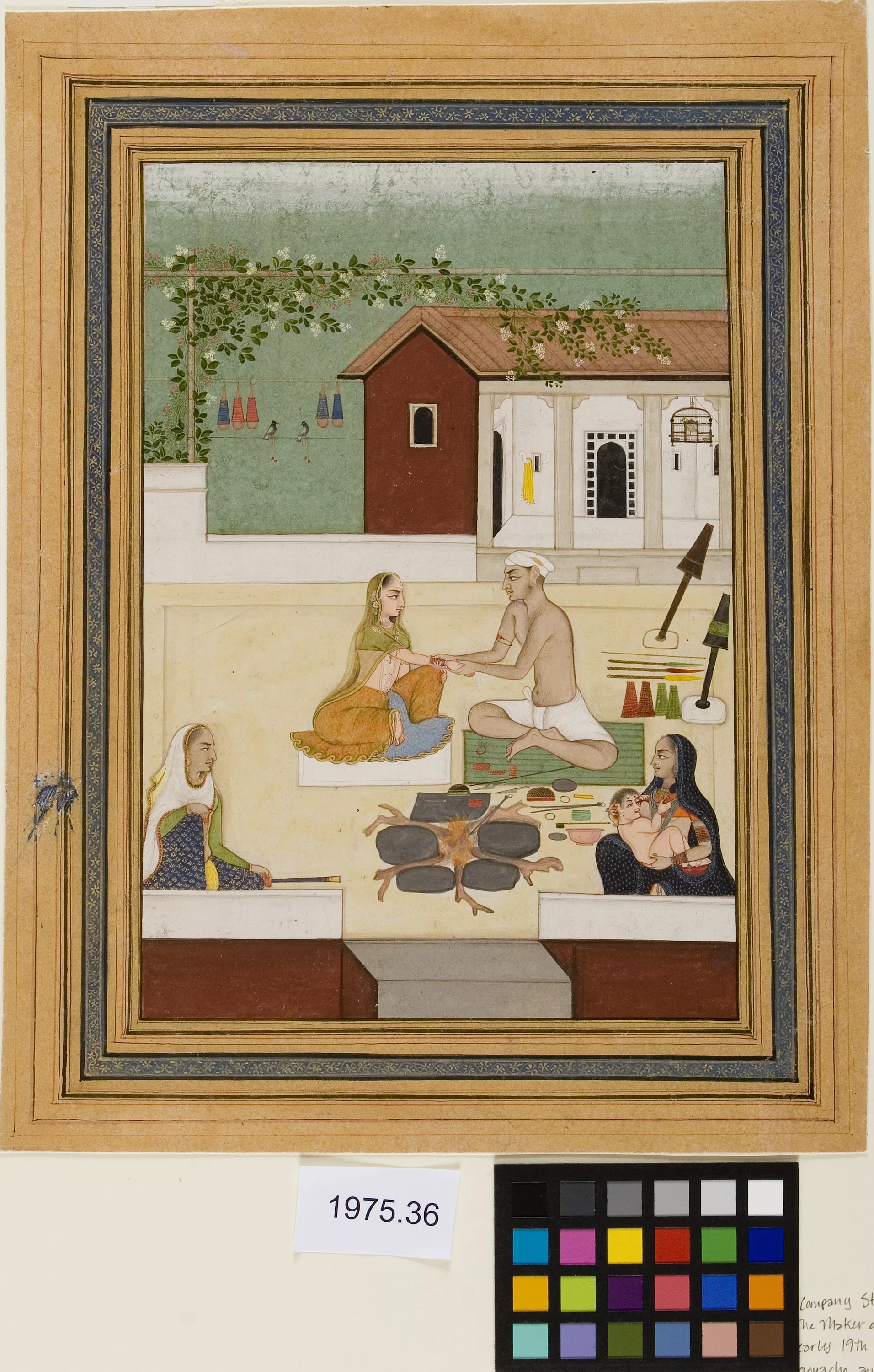Exhibit
Creation Date
1800
Height
23 cm
Width
16 cm
Medium
Genre
Description
Art historian Pramod Chandra describes this scene:
A lady, who has taken her seat opposite the craftsmen, is trying on bangles. The various tools of the trade are laid out before the man, including a fire used to shape lacquer. In the foreground is an aged duenna, the lady’s escort, and a woman nursing a child, apparently the bangle maker’s wife. In the background is a tiled cottage and a creeper wound on a bamboo scaffolding. The miniature is still close to the traditional style, but the rather cool colors represent an adjustment to British taste.
This image utilizes a hybrid, Indo-European style that draws its subject matter—a bangle maker—from the classificatory projects of both the British government and the caste system. Similar to the subject of A Painter at Work, both craftsmen wear a short loincloth, a band on their right arm, and a turban on their heads. The only difference is that the bangle maker’s left shoulder is not covered with a shawl, consequently demonstrating his low status in the caste hierarchy. This hybrid style is also apparent in the stylization of the women’s dresses, which is similar to that seen in traditional Mughal and Indian paintings such as Raja Jagat Prakash.
During the time this image was created, Britain established a centralized government in India. Because it is unknown who the artist was and where he was located during the execution of the work, it is unclear what types of cultural interactions may have occurred between the artist and his patron. Mildred Archer states that Company paintings were made for and marketed to European patrons that were employed by the East India Company (Archer 1-19). However, sultans and princes under British rule may also have been patrons of Company-style paintings, as many Indian princes and rajahs in the late eighteenth and mid-nineteenth centuries were patrons and collectors of European art (Sutton 15-17). This trans-cultural contact through the exchange of art had an early precedent in the reigns of the Mughal rulers. One of the earliest recorded accounts occurred in 1580, when Akbar (r. 1556-1605) invited Portuguese Jesuits living in Goa to stay at his palace in Delhi. The exchange of engravings, manuscripts, and books led to the production of a panoply of Christian images that adorned Akbar’s court (Bailey 24-5).
The type of the "bangle maker" as reproduced in Company style images reflects the visual classification that came to dominate interactions in India during the Romantic and Victorian periods. Developing scientific theories such as social Darwinism, phrenology, physiognomy, and anthropology augmented the need to hierarchically classify human beings. (Ryan 156-71). In addition to the racial typing that occurred throughout the nineteenth century, the classification of types by profession appears to stem from the social segregation prominent in the caste system. Rather than determining or identifying social status by means of specific bodily features, the caste system distinguishes status according to the professional class one inherits at birth: Brahmins are priests or teachers, Kshatriyas are rulers, Vaishyas are farmers, and Shudras are artisans (Mitter 41). These distinctions were made visible in the types of clothing, especially the types of headdress, which Indians wore.
Accession Number
1975.36
Additional Information
Bibliography
Archer, Mildred. Company Paintings: Indian Paintings of the British Period. London: Victoria and Albert Museum in association with Mapin Publishing, 1992. Print.

